In pursuit of harmony, toned and harmonious figure, people start to exercise and follow a healthy diet. The first problem to face is the diet. Few people know that the problem lies in consuming too many simple carbohydrates. And as soon as they researched the information in popular sources, without reading it to the end, they completely excluded carbohydrates from their diets. And here the breakdowns, health problems, loss of strength and so on begin. Where is the balance and truth? Very close! Let's find it.
Over the past few years, there has been a significant shift in opinions about why a person gains weight. Many people have realized that carbohydrates, not dietary fats, are converted to subcutaneous fat, and become one of the main causes of obesity.
For a long time, low-fat diets have been the basis of weight loss methods, but the real feeling is that low-carbohydrate diets are highly effective in weight loss. Studies have shown that simple and complex carbohydrates have different effects on the body. Consuming too many foods high in carbohydrates leads to overweight.
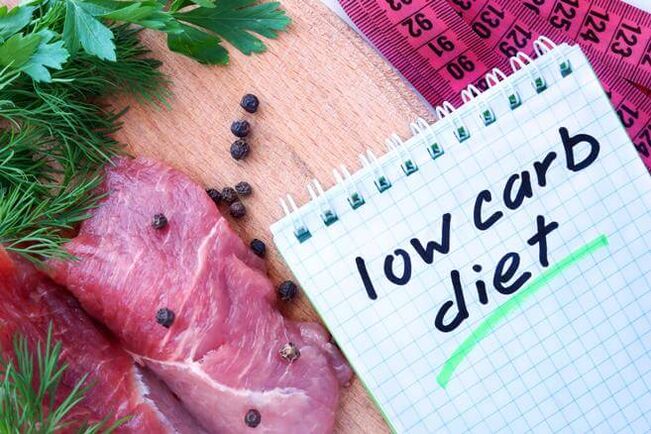
In this article, you will learn:
- What is a low-carbohydrate diet and how does fat-burning work;
- advantages and disadvantages of the method;
- what foods to include in a low-carbohydrate diet;
- Fun low carb recipes for a complete menu.
What is the essence of the weight loss method?
Carbohydrates provide the body with the necessary amount of energy used during the day for important processes and during physical activity. A complete rejection of a macronutrient will lead to malfunctioning of functional systems, and an excess of received energy will lead to an increase in fat reserves. Low-carb diets that include slow (complex) carbohydrates don't cause blood sugar spikes and take longer to convert to energy.
The essence of this method lies in the fact that, from the first day of a safe and effective weight loss diet, the amount of carbohydrates consumed decreases and protein increases each day. Thanks to this, the following processes are launched in the body:
- The previously received energy is in short supply, which forces us to look for a new source.
- Glycogen in the first 2-3 days of the diet becomes the main source of energy.
- Moreover, fat is broken down, synthesizing an additional source of energy - ketones.
Studies comparing the benefits of low-carb and low-fat diets on weight loss have shown that people who minimize their carbohydrate intake lose more weight in 6 months than those who follow a low-fat diet.
With a low-carbohydrate diet, subjects felt full after eating, because protein and fat break down more slowly than carbohydrates. In addition, the rise in blood sugar and insulin production happens gradually. This means that they don't have a strong burst of energy, but rather fatigue and a heightened sense of hunger.
Inference: the principle of the diet is that biochemical processes contribute to fat burning and weight loss.
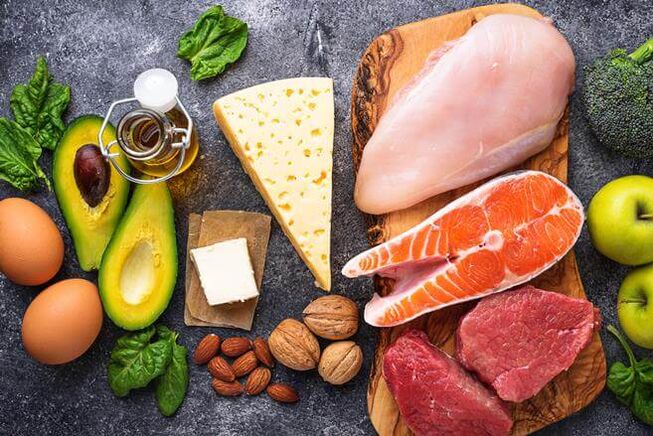
It should be remembered that during the diet, the fat layer decreases evenly throughout the body, so it cannot be reduced locally.
Advantages and disadvantages
The low carbohydrate content in the menu has a favorable effect on the state of the body, normalizes digestion, increases metabolism and rejuvenates.
Advantages:
- there is no dietary hunger, energy remains at the same level, there is no weakness;
- suitable for diabetics;
- suitable nutrition for men and women with the aim of losing weight;
- suitable for low, medium and high activity levels;
- does not require a significant change in the calculation of the daily calorie requirement for weight loss, the indicators of protein and carbohydrates change.
Reducing the intake of macronutrients promotes weight loss and improves health, it is recommended for:
- overweight;
- intensive training;
- diabetes mellitus;
- hypertension;
- endocrine system disorders;
- cancer.
This method has earned the confidence of athletes and bodybuilders - it is a reliable opportunity to lose fat, reduce the percentage of subcutaneous fat and maintain muscle mass.
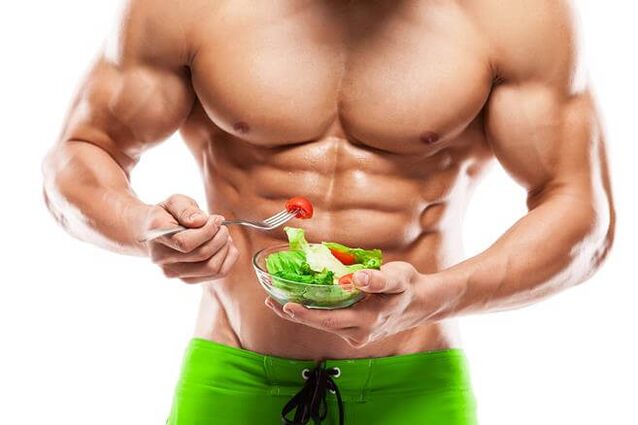
However, the diet has its downsides:
- constipation - reduced fiber, which is associated with reduced carbohydrate intake, which can lead to digestive problems;
- carbohydrate starvation can cause headaches, irritability and nervousness;
- exacerbations of chronic diseases;
- increased load on the liver;
- potassium and sodium deficiency;
- carbohydrate deficiency reduces the ability to concentrate, which is important for people who do mental work;
- an increase in cholesterol levels due to a large number of animal products, which causes the development of diseases of the cardiovascular system;
Low-carb diets are not on the list of methods that can be followed for several years, as a large list of prohibited foods will create additional stress on the body. Thus, after several weeks or months of restriction, a person returns to his or her normal diet.
Balance protein, fat, carbohydrates
The main protein sources of a low-carbohydrate diet are animal products: meat, poultry, offal, cheese, eggs. For vegetarians, legumes and nuts are an alternative.
Dietary BJU ratios range from:
- Protein 40 - 50%;
- Fat 30-35%;
- Carbohydrates 20-25%.
Opinions of nutritionists
Nutritionists are wary of this approach, as a low-carb diet (for a week or a month) implies using 50-70 g of macronutrients per day. Deficiency leads to undesirable disorders with some side effects, like surplus.
Doctors recommend prioritizing a reasonable and balanced diet, controlling the amount of food containing carbohydrates. Healthy eating habits combined with physical activity will help reduce body fat - the method cannot be said to be rapid weight loss without harm to health.
Contraindications
Before "dieting" you should consult your doctor, because high-protein foods are contraindicated for people with impaired metabolism (eg, urolithiasis, gout).
The fact that with a normal diet, these metabolic disorders may not manifest themselves, means that you may not even know that you have the disease. By changing your diet in the direction of increasing protein intake, you are triggering the start of a serious pathological mechanism in the body.
Contraindications to excessive consumption of fatty foods in diseases of the gastrointestinal tract (cholecystitis, pancreatitis, gallstones, peptic ulcer, gastritis). Fatty foods stimulate the absorption of large amounts of cholesterol into the body, which can cause or accelerate the development of atherosclerotic plaques.

Weight loss methods are also not recommended:
- pregnancy and lactation;
- people under 18 years old;
- with cardiovascular diseases;
- at the time of exacerbation of chronic diseases.
The basic rules for a low carb diet
This method involves the use of a minimal amount of carbohydrates sufficient to maintain the body's functioning. For women, 2 grams are needed per kilogram of weight, for men - 3 g, if the daily intake is 120-150 g, then for weight loss this figure is gradually reduced and gradually reduced to 50-70 g per day. Protein foods become an alternative source of energy and maintain muscle tone.
Low-carbohydrate diets lower insulin levels, suppressing appetite. Ketone bodies, which come from animal and vegetable proteins and fats, block the flow of information about hunger.
Following a few principles will help you achieve your goals:
- exclude products with a high glycemic index from the diet;
- take vitamin and mineral supplements;
- Preferred cooking methods are stewing, boiling, baking, steaming. Fry the ingredients without adding oil or in small amounts;
- do not skip meals and do not reduce calories;
- eliminate complex carbohydrates in the first half and before training, in the second - protein foods;
- be sure to eat breakfast;
- compliance with the drinking regime: at least 2 liters of clean liquid.
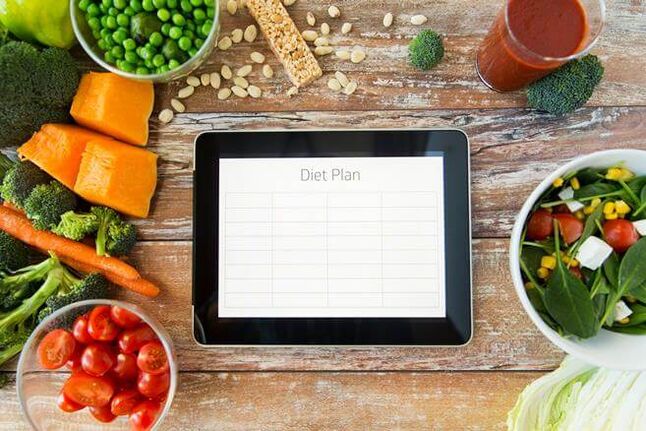
Don't forget that accurately calculating your daily energy needs for weight loss is the first step before starting any diet.
Approved products
The list of products to maintain a low-carbohydrate diet is very extensive, which helps to diversify the menu and does not make you hungry. It is important to research ingredient information using the food calorie table or on the label.
Allowed Product Table
The diet implies certain restrictions. With the help of a table, you can familiarize yourself with the right products for a low-carbohydrate diet.
Product Groups |
Approved products |
|---|---|
Meat |
Lean pork, veal and beef, poultry, offal |
Fish and seafood |
Sea fish: salmon, trout, cod, mackerel, herring, tuna, halibut Seafood - unlimited |
Dairy products |
Cheese sticks, cottage cheese, kefir, natural yogurt with no additives - all low in fat |
Egg |
Chicken and quail |
Raw and canned vegetables |
Everything except starchy vegetables: potatoes, Jerusalem artichokes, sweet potatoes |
Mushroom |
Not limited in any way |
Fruits, berries |
Citrus, green apple without sugar |
cereal |
Long-cooking oatmeal, brown rice and buckwheat |
Nuts and seeds |
Borderless |
Oil |
Unrefined vegetables |
Sauce |
Balsamic vinegar |
Sweeteners |
Free of sorbitol and fructose |
Drinks |
Coffee, tea - no added sugar, mineral water, vegetable juice |
Prohibited products
If your favorite product is not on the list of permitted ingredients, it is most likely on the prohibited list:
- bakery and confectionery products;
- processed cereals (white rice, instant oatmeal, semolina), premium pasta;
- potatoes, corn;
- semi-finished products, smoked products;
- food ingredients (mayonnaise, ketchup and sauces, excluding soybeans);
- chocolate;
- sweet fruits (banana, grapes);
- sugar and sugar products;
- packaged juices, fruit drinks (due to added sugar);
- Soft drink;
- acoholic drink.

It is necessary to give up the above products for the first time and, after 3-4 weeks, gradually return them to the diet in small portions.
Sample menu of the week
At first glance, a low-carb diet may not seem like much, but when you prepare a menu a week in advance, you can be sure that the diet is full.
Table: sample low-carb diet menu for 7 days
The table features possible combinations of breakfast, lunch and dinner, which can be taken as a base and replaced with your favorite meal. Do not forget that it is important to accurately calculate the calorie content of the finished dish to match the daily energy intake. It is possible to rotate and repeat the products.
Day |
Breakfast |
Monday breakfast |
Dinner |
afternoon tea |
Dinner |
|---|---|---|---|---|---|
1 day |
Cheese casserole without sugar + tomato / cucumber |
Grapefruit |
Vegetable brown rice porridge |
Kefir 1% |
Steamed fish + coleslaw + bread |
2 days |
Omelette or two-egg omelette + chicken |
Fresh cheese without fat |
Low-fat sour cream mushroom soup + bread |
Kefir 1% with chopped cucumber and herbs |
Boiled beef + cucumber and tomato salad |
3 days |
Vegetable stew with grated cheese |
Apple |
Vegetable soup with chicken broth |
Milk 1. 5% |
Boiled breast + stewed cabbage |
4th |
Oatmeal with apple puree |
Grapefruit |
Buckwheat porridge + beetroot salad |
Fresh cheese without fat |
Veal or chicken with vegetables |
Day 5 |
Cheese + boiled egg |
Apple |
Brown rice + boiled seafood |
Kefir 1% |
Vegetable salad + lean beef |
6th |
Cheese + boiled egg + bread |
Natural yogurt without sugar 1. 5% |
Grilled meat + vegetable salad |
Kiwi |
Stewed vegetables + boiled fish |
7th |
Milk buckwheat porridge |
Fresh cheese without fat |
Grilled fish with vegetables |
Kefir 1% |
Grilled breast + raw vegetables and herbs |
Long-term low-carb diets (from 30 days) should include a cheat meal or extra food to avoid slowing down the metabolism.
Get out of the diet
A low-carbohydrate diet is effective and affordable, but after 2 months you need to return to a normal diet. The exit is done gradually in order to minimize the stress on the body and not regain the previously lost kilos.
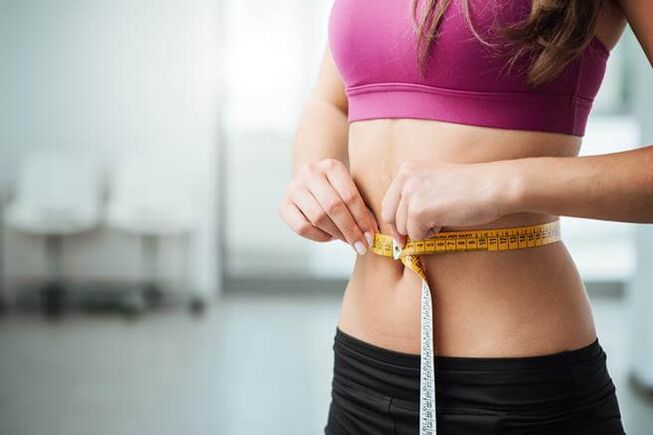
Return to normal diet after 3-4 weeks:
- in the first and second weeks, the amount of fruits and green (non-starchy) vegetables increases;
- third week - reduce protein foods by adding cereals;
- The number of calories is also increasing every day.
What to cook during weight loss - delicious recipes
A diet low in carbohydrates is no reason to limit your intake of chicken fillets. The list of allowed products is extensive, so you can cook time-tested or imaginative dishes based on readily available ingredients.
Chicken fillet in slow cooker
Recipe #1
Cooking method:
- Wash chicken fillet and remove excess fat. Cut into pieces of your choice, sprinkle with salt and spices, and place on the bottom of a bowl containing many cakes.
- Pour in water, add bay leaves.
- Cook for 1. 5 hours in the "Extinguish" mode.
Total carbs: 0 g
Element:
- chicken fillet - 250 g;
- water - 150 g;
- salt, ground pepper - to taste;
- bay leaf - 1 pc.
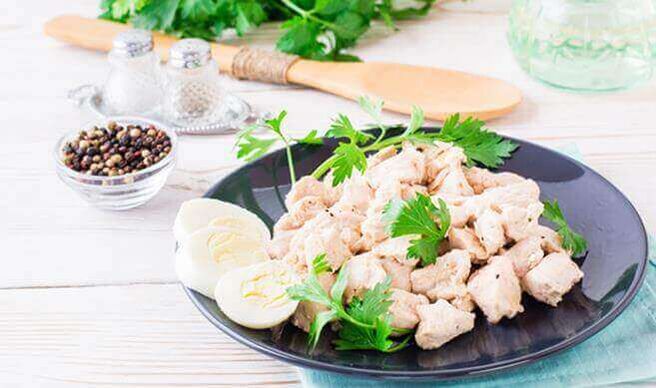
Veal with cheese in the oven
Recipe #2
Cooking method:
- Rinse meat in cold water, cut to length, smash.
- Oil the baking sheet, place the veal, pour in the milk.
- Place in a preheated oven at 180 degrees for 40 minutes.
- Immediately after, salt the meat, add salt and spices to taste.
- Cut the cheese into thin slices, spread evenly over the meat, put in the oven for another 30 minutes.
Total carbs: 7. 7 g
Element:
- veal - 400 g;
- cheese - 100 g;
- milk 1. 5% - 100 ml;
- vegetable oil - 20 ml;
- salt, pepper, spices - to taste.
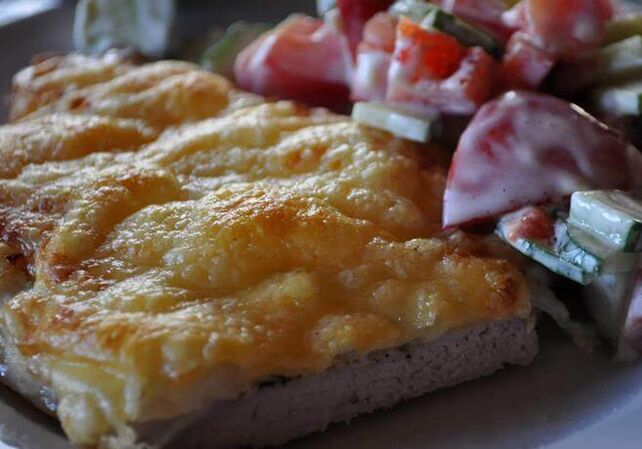
Soup with oat bran
Recipe #3
Cooking method:
- Cut the turkey fillet into cubes, boil in 1 liter of water for 20 minutes.
- Finally, add the minced onion and bran.
- Boil an egg, cut it into small pieces and put it in the broth.
- Finely chop green vegetables, put in soup pot.
Total carbs: 24 g
Element:
- turkey fillet - 150 g;
- water - 1 l;
- onion - 60 g;
- eggs - 58 g;
- oat bran - 25 g;
- dill chopped - 10 g;
- green onions - 5 g;
- salt, pepper - to taste.
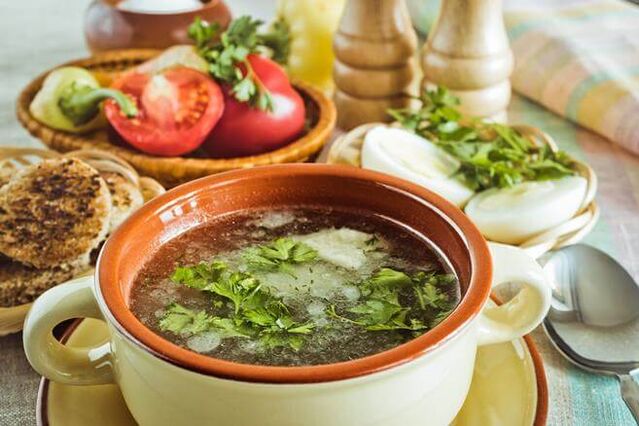
Cabbage fruit salad
Recipe #4
Cooking method:
- Peel the oranges and remove the white layers.
- Fruit cut into squares.
- Finely chop cabbage and onions. Combine all ingredients.
- Season with salt to taste, season with lemon juice, mix well.
Total carbs: 16. 5 g
Element:
- Chinese cabbage - 150 g;
- apple - 50 g;
- orange - 60 g;
- green onions - 5 g;
- lemon juice - 20 ml;
- salt - to taste.
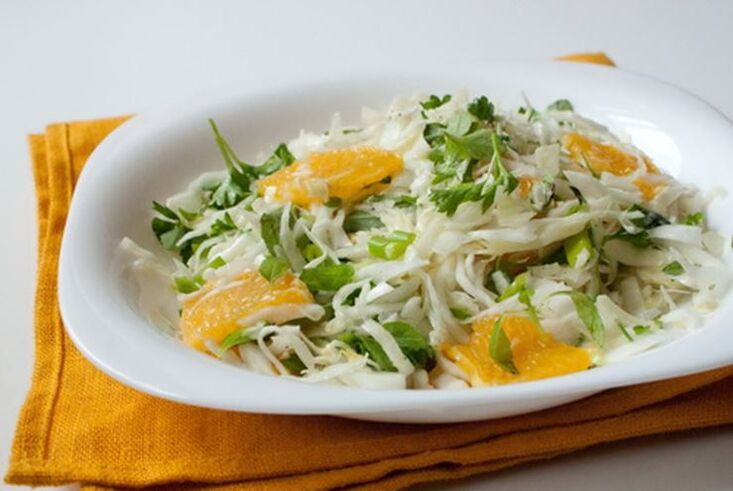
squid salad
Formula number 5
Cooking method:
- Boil two eggs, peel them. Cut into medium squares.
- Wash the squid body, peel and remove the intestines, soak in boiling water for 15-20 seconds, do not blanch! Otherwise, they will become "rubber".
- Cut seafood into thin slices or strips.
- Cucumber cut into thin strips.
- Mix all ingredients.
- Mix salad with juice and olive oil.
Total carbohydrates: 3. 5 g.
Element:
- chicken eggs - 116 g (2 pcs);
- squid - 150 g;
- cucumber - 70 g;
- lemon juice - 15 ml;
- olive oil - 15 ml.
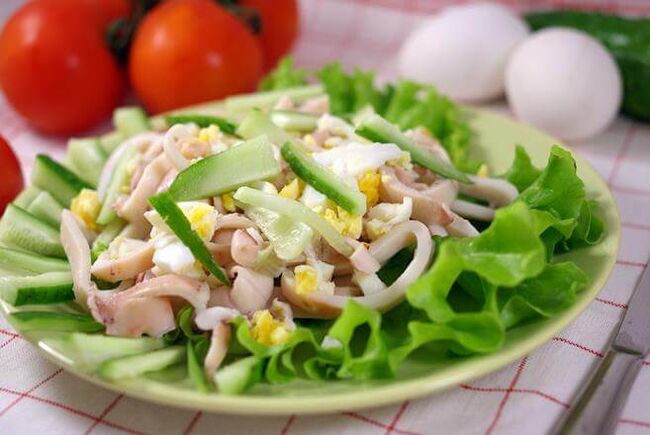
White fish with vegetables
Recipe # 6
Cooking method:
- Wash the fish, remove the fins. Cut into medium pieces, season with salt and pepper.
- Chop the vegetables.
- Spread all ingredients evenly on a baking sheet.
- Bake in preheated oven at 180 degrees for 50-60 minutes.
Total carbs: 8. 7 g
Element:
- cod - 500 g;
- eggplant - 80 g;
- tomatoes - 120 g;
- salt and pepper.
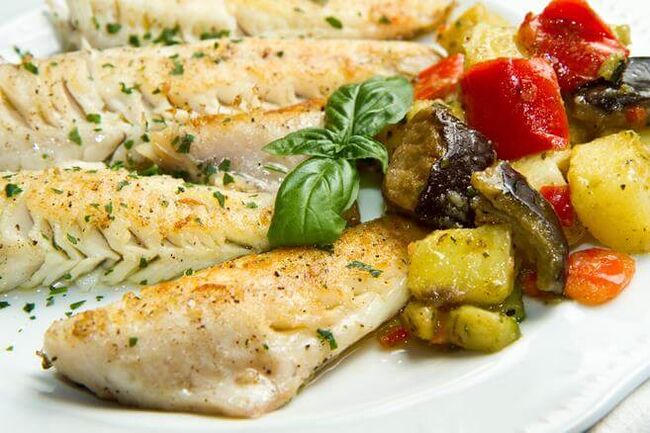
Cheese soup
Formula No. 7
Cooking method:
- Boil chicken fillet until tender, remove meat to cool. Cut into medium pieces.
- Grated cheese on a coarse grater, add to broth, cook over low heat for 20 minutes until a homogeneous mixture is obtained, stirring constantly. Add salt and pepper to taste.
- Spread chicken fillet in each serving. Decorated with green plants.
Element:
- chicken fillet - 300 g;
- processed cheese - 100 g;
- water - 1. 5 l;
- salt, pepper - to taste;
- fresh herbs - to taste.
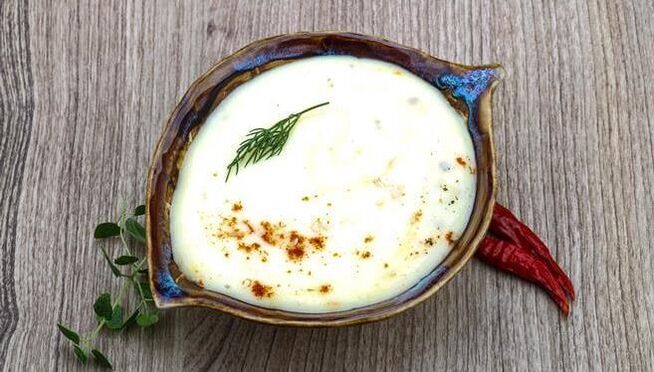
Whey
Formula number 8
Cooking method:
- Pour milk into a deep mold to whip, place in the freezer until frozen.
- Pour gelatin with water, cook according to the instructions, add gelatin. Cool down.
- Remove the milk, beat with a immersion blender, add the gelatin and beat again.
- Place in freezer for 20 minutes.
Total carbs: 9. 9 g
Element:
- milk 0. 5% - 200 ml;
- gelatin - 10 g;
- water - 40 ml;
- sweetener - to taste.
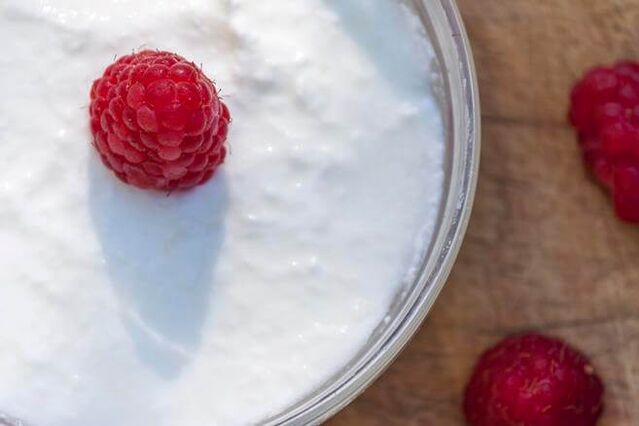
Salad with canned tuna
Recipe # 9
Cooking method:
- Finely chop the onion into halves, drizzle with vinegar, mix well and leave for 15 minutes. After draining the excess liquid.
- Boil hard-boiled eggs, grate cheese on a coarse mortar.
- Cut cucumber into strips.
- If the tuna is too large, use a fork to mash the tuna pieces.
- Mix all ingredients, season with oil, add salt and pepper to taste.
Total carbs: 7. 5 g
Element:
- canned tuna - 1 can, about 180 g;
- eggs - 58 g;
- hard cheese - 100 g;
- cucumber - 100 g;
- onion - 40 g;
- vinegar - 5 ml;
- olive oil - 15 ml;
- salt, pepper - to taste.
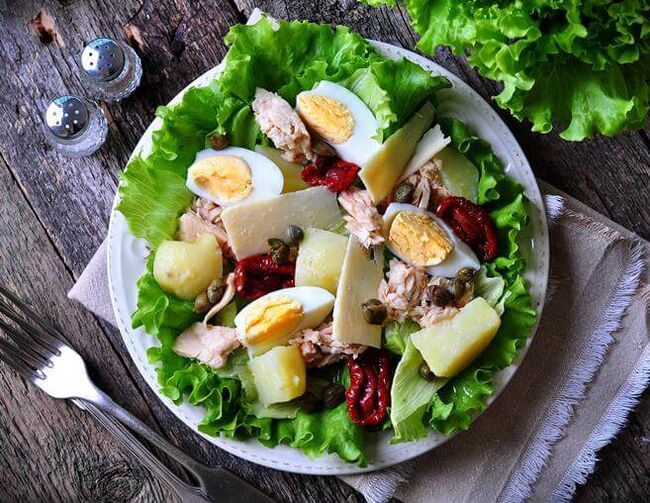
Diet cutlets
Formula No. 10
Cooking method:
- Rinse all meats, pat dry on paper towels, finely chop or mince with a meat grinder/grinder.
- Cut the onion into small squares.
- Add eggs, onion, salt and spices to minced meat. Mix well, forming balls with wet hands.
- Steam for 20-30 minutes or fry in a non-stick pan without oil on both sides.
Total carbohydrates: 7 g.
Element:
- beef shoulder - 200 g;
- lean pork - 400 g;
- chicken fillet - 250 g;
- onion - 60 g;
- chicken eggs - 58 g;
- salt, spices - to taste.
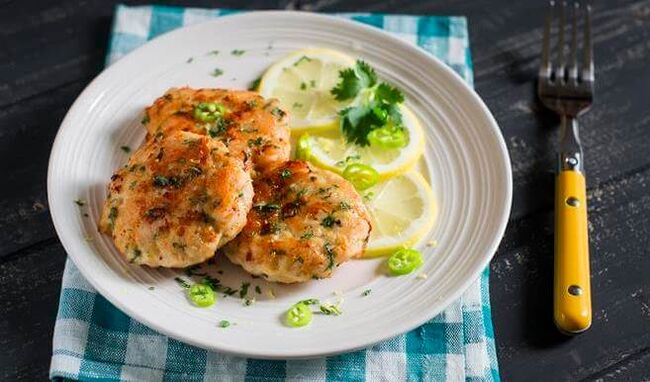
Low carb Raffaello
Recipe # 11
Cooking method:
- The curd must be dry. Grind a small portion of cheese with sweetener through a sieve, add sour cream, mix well.
- Dry almonds in a hot non-stick pan for 7-10 minutes, stirring constantly.
- Seal a small piece of cheese, flatten, put an almond inside, roll into a ball.
- Roll the finished candy in coconut flakes and refrigerate for 1 hour.
Total carbs: 28. 1 g
Element:
- cottage cheese 1, 8% - 250 g;
- sour cream 10% - 40 g;
- raw almonds - 20 g;
- grated coconut - 100 g;
- sweetener - to taste.
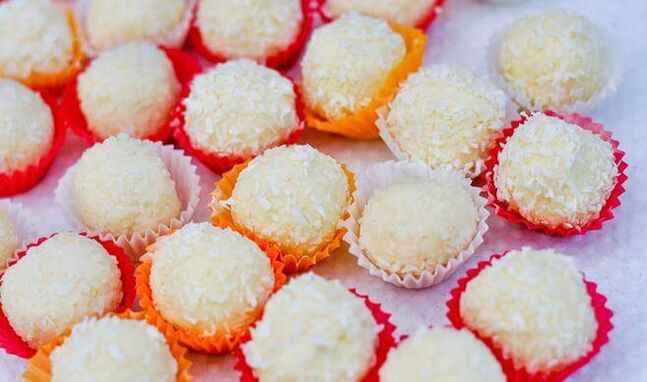
Low-carbohydrate diet is an effective weight loss method with a varied menu. By following the recommendations, you can quickly achieve the desired results and do not have to worry about the return of the lost weight after leaving the calcium reduction regimen. Carefully study the contraindications, monitor your state of health and stay healthy!












































